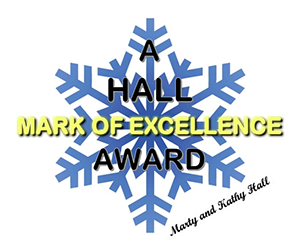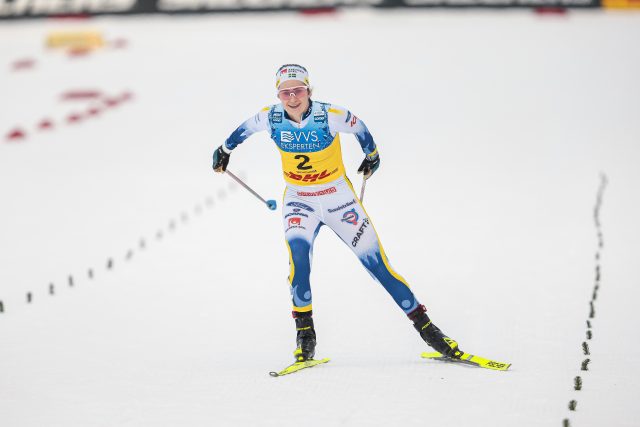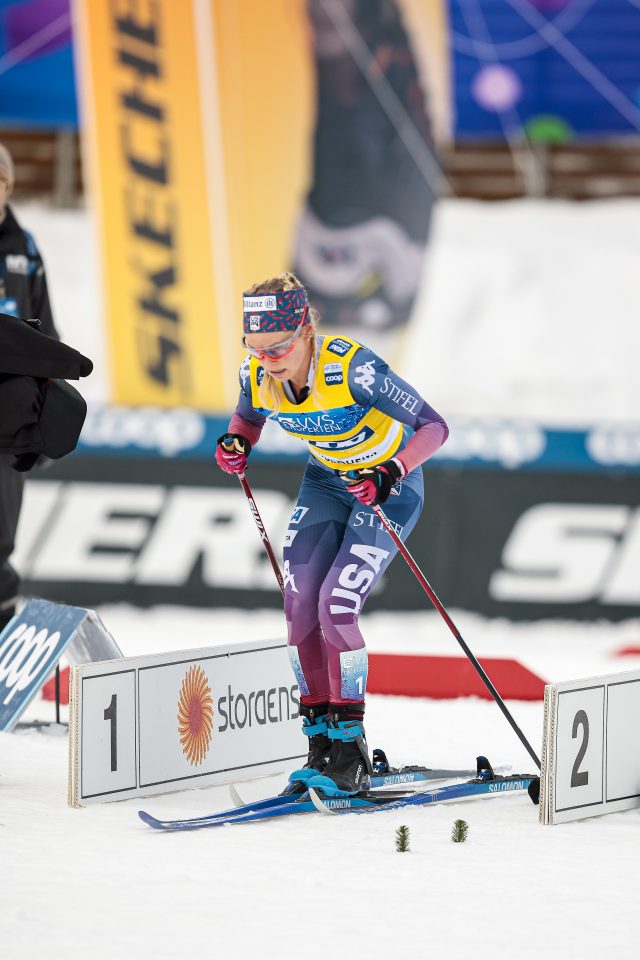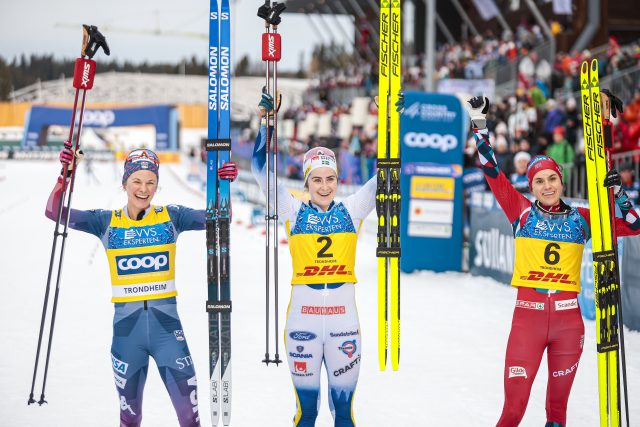 This coverage is made possible through the generous support of Marty and Kathy Hall and A Hall Mark of Excellence Award. To learn more about A Hall Mark of Excellence Award, or to learn how you can support FasterSkier’s coverage, please contact info@fasterskier.com.
This coverage is made possible through the generous support of Marty and Kathy Hall and A Hall Mark of Excellence Award. To learn more about A Hall Mark of Excellence Award, or to learn how you can support FasterSkier’s coverage, please contact info@fasterskier.com.

One of Norway’s most picturesque cities, Trondheim is also one of Norway’s least-wintry cities. The first three weekends of World Cup racing—Ruka, Gaelivare, and Oestersund—were an Arctic blast. The second day of World Cup competition in coastal Trondheim offered a morning that dawned cloudy and dreary, with rain in the forecast and temepratures hovering in the low 40’s F at race time. A foggy drizzle was suspended in Trondheim’s coastal air; humidity levels approached 100%. This would be a day heavily reliant on the skills and intuitions of each team’s wax technicians. Ski preparation was likely to be crucial, both in the tricky-to-prepare kick wax conditions, AND in the new waxing rules that prevent the use of fluoro waxes that, in the past, would have been heavily relied upon on such a warm day. Glide would be a challenge, kick would be a challenge . . . with World Cup points, prize money, and bragging rights at stake.
“It was definitely tricky today for the wax technicians,” reasoned Rosie Brennan (USA). “We haven’t had these conditions so far this year; also, it didn’t switch to this condition until literally last night.”
Ski choices and base prep may have played a role in Brennan’s freestyle leg, as well. “In classic . . . I had a pair of skis that I knew had worked well last year. [But] in skate we didn’t find the best pair, didn’t make the best decisions . . . I guess we will see these conditions again, so there’s room to learn and grow from that.”
After her fourth-place finish in Friday’s Sprint, Jessie Diggins (USA) entered Saturday’s 20 k Skiathlon leading the season-long World Cup Overall chase: 34 points ahead of Emma Ribom (SWE). Rosie Brennan entered the day in third place in the World Cup overall standings, 33 points behind Ribom. Sitting first and third in the points standings, Diggins and Brennan lined up front and center for Saturday’s World Cup Skiathlon in Trondheim, Norway.
Trondheim’s World Cup Skiathlon delivered Ebba Andersson (SWE) her second victory of the season—the seventh World Cup win of her career—in conditions that proved challenging for athletes and ski technicians, alike. Ultimately, Diggins was able to finish second on the day, while Brennan pressed the pace early in the Classic leg before fading to eighth. Other American finishers included Nove McCabe 23rd, and Alayna Sonnesyn in 42nd. Julia Kern was originally slated to race, but it was reported before race time that she would not start. Among Canadians, Katherine Stewart-Jones finished 33rd, and Amelia Wells 46th.
Women’s 20 k Skiathlon
Skiathlon is a World Champinship and Olympic event—sometimes contested as a stage of the Tour de Ski—though on the World Cup tour it’s an event that is rarely scheduled more than once a season. Trondheim’s event also represented the first ever World Cup Skiathlon contested at the 20 k distance (usually it’s a 2 x 7.5 k), so this represented a significant opportunity for distance skiers. The Trondheim course offered two different courses—one Classic, one Freestyle—raced over three laps of 3.3 kilometers each.
Time checks at 3.9 k and 15.9 k offered a race-within-a-race, as World Cup bonus points would be awarded at those intermediate checkpoints. With the race for season-long World Cup being a closely contested affair in the early season, it appeared likely that someone would go out early in pursuit of those points. Andersson and Brennan obliged . . .
“I definitely knew that my Classic skiing has been going well this year,” said Brennan. “So, when my skis were good I thought I’ll try to keep pace with whoever’s leading . . . I feel like I’m in good shape, and it’s possible for me to ski 20 k with the lead. It’s always great when that also gets you some bonus points, but it’s rare that I start a race thinking that, but if you’re in the position I think it’s a good thing to go for.”
Andersson pushed to the front of the pack through the first lap, marked by Brennan and Astrid Oeyre slind (NOR). Andersson claimed the 15 points at 3.9 k ahead of Brennan and a group of chasers that formed behind them (led by Austrian, Teresa Stadlober, Olympic bronze medalist in this event). Andersson continued to lead through the end of the second Classic lap, with the chase group having briefly reeled in the breakaway as the field raced through the stadium. Andersson continued to press the issue in the final Classic leg, with only Brennan able to follow closely.
Unlike Diggins, Andersson didn’t ski the heats and finals in Friday’s Sprint competition. With Diggins having won the last two 10 k Freestyle competitions by 20+ second gaps, Andersson may have been hoping to establish an advantage before the start of the final freestyle leg, and she worked hard to enter the stadium at the end of the 10 k Classic leg with a lead of three seconds over Brennan, and 15 seconds over Diggins.
“My goal [in the Classic leg] was to stay smooth and smart, and just ski as relaxed as possible, Diggins said. “But then I realized I had awesome kick, but really really slow glide (which could’ve been my fault as a result of asking for more kick). Regardless, it meant that I was getting really dropped on the downhills. So, I started trying some alternative strategies—skating outside the tracks, skating at the far edge (nearly skiing off the track)—and that really helped. And I was proud of myself for getting creative.”
Diggins went on to describe the interior monologue that played out while she struggled through the Classic leg:
“[I realized] I’m not going to have the best classic leg, “ she remembered. “But if I can make it to the skate leg without blowing up, then I’m going to charge and really see what I can do.”

Freestyle Leg
There were no apparent issues among the leaders in the transition from Classic to Freestyle, and all contenders exited the stadium in gaps similar to the way they entered. Diggins lost a few seconds in the transition, but she had narrowed her 20 second Classic deficit to 15 seconds before the exchange to Freestyle.
Diggins went to work—with Heidi Weng (NOR) in tow—quickly whittling down the gap to the group of early leaders, though Andersson had escaped off the front. Once the climbing began on the first Freestyle lap, Diggins pressed to the front of the chase group, her pace detaching Brennan and Victoria Carl (GER) as the group pressed forward in pursuit of Andersson.
Alone at the front, Andersson continued to ski strongly while Diggins cooperated with the other members of a chase group who seemed content to race for second. When Diggins would go to the front, the gap to Andersson would be reduced. When anyone else led (usually Stadlober) the gap to Andersson would widen. With one 3.3 k Freestyle lap remaining, Andersson enjoyed a gap of nearly 25 seconds.
Tactically, Diggins found herself somewhat isolated in her attempts to catch Andersson. “When I was leading, I was like ‘We’re gonna chase her down! We can totally catch her!’” she said. “But I wasn’t really getting the help I need in that endeavor.”
Diggins explained her tactical adjustments in the final lap of the Freestyle leg: “I had a lot of confidence from [yesterday’s] sprint,” she said. “I know if I can get around that top corner first, then I should be able to hold the gap . . . and that ended up happening!”
Ultimately, Andersson enjoyed a winning margin of just over 15 seconds, similar to what she had built at the end of the Classic leg. Diggins crossed the finish line alone in second, having carved into Andersson’s lead over the final kilometer.
Weng returned to the podium (for the second time this season) in third, Stadlober fourth, Slind fifth, Carl Sixth.
Women’s 20 k Skiathlon RESULTS

John Teaford
John Teaford—the Managing Editor of FasterSkier — has been the coach of Olympians, World Champions, and World Record Holders in six sports: Nordic skiing, speedskating, road cycling, track cycling, mountain biking, triathlon. In his long career as a writer/filmmaker, he spent many seasons as Director of Warren Miller’s annual feature film, and Producer of adventure documentary films for Discovery, ESPN, Disney, National Geographic, and NBC Sports.



